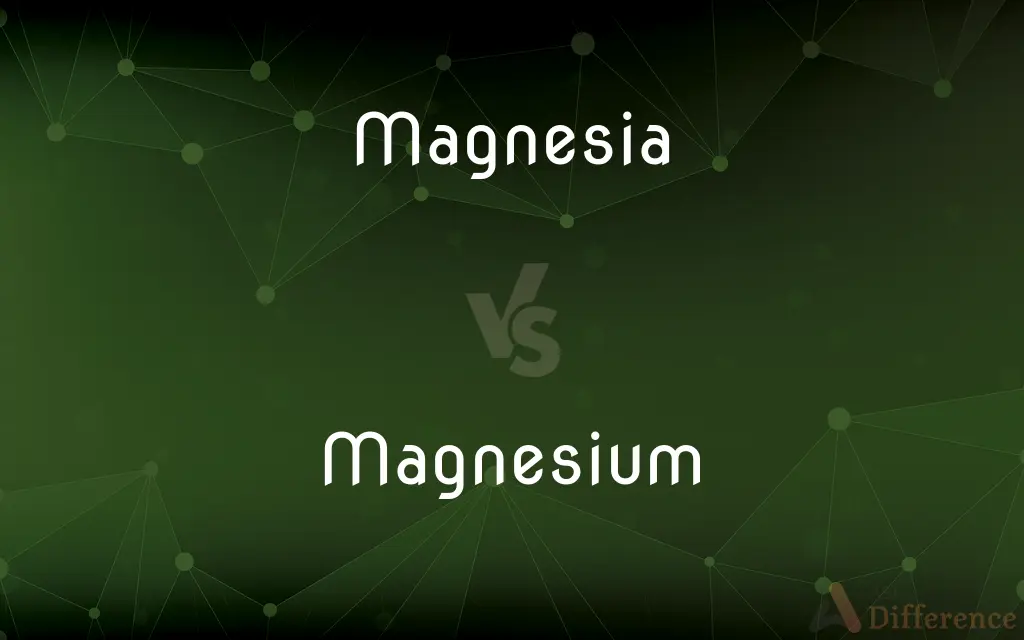Magnesia vs. Magnesium — What's the Difference?
Edited by Tayyaba Rehman — By Fiza Rafique — Updated on September 27, 2023
"Magnesia" refers to magnesium oxide (MgO), a white solid, while "Magnesium" is a silver-white metallic element found in nature and is essential for human health.

Difference Between Magnesia and Magnesium
Table of Contents
ADVERTISEMENT
Key Differences
"Magnesia" is the term used for magnesium oxide, a compound comprising one magnesium and one oxygen atom. On the other hand, "Magnesium" denotes the elemental form, a metal with the symbol Mg on the periodic table.
The primary use of "Magnesia" is as a refractory material in furnace linings due to its high melting point. "Magnesium," however, is used in various applications, from being an alloying agent in aluminum to serving as a component in fireworks.
While "Magnesia" exhibits characteristics of a ceramic and is a good insulator, "Magnesium" as a metal is a conductor of electricity and heat.
Many over-the-counter antacids and laxatives contain "Magnesia" for its neutralizing properties. Conversely, "Magnesium" supplements are consumed to ensure adequate intake of this essential mineral.
Both "Magnesia" and "Magnesium" have significant roles in human health. While "Magnesia" is used for treating heartburn and constipation, "Magnesium" is crucial for muscle and nerve function, bone structure, and energy production.
ADVERTISEMENT
Comparison Chart
Chemical Nature
Compound (Magnesium Oxide)
Element
Appearance
White Solid
Silver-white Metal
Main Use
Refractory material, Antacids
Alloys, Dietary Supplements
Electrical Conductivity
Insulator
Conductor
Health Relevance
Used for heartburn & constipation treatment
Essential mineral for various bodily functions
Compare with Definitions
Magnesia
Magnesium oxide compound.
The antacid contains magnesia to neutralize stomach acid.
Magnesium
A silver-white metallic element.
Magnesium burns with a brilliant white flame in air.
Magnesia
Neutralizing agent in antacids.
The antacid's active ingredient was magnesia, effective for acid indigestion.
Magnesium
Common in the Earth's crust.
Magnesium is often extracted from minerals like dolomite and magnesite.
Magnesia
Common ingredient in laxatives.
The doctor recommended a dose of magnesia for his constipation.
Magnesium
Essential mineral for human health.
Many people take magnesium supplements for better bone health.
Magnesia
A white solid used in medicine.
Magnesia was prescribed to alleviate her heartburn.
Magnesium
Used in alloys and fireworks.
Aluminum alloys often contain magnesium to increase their strength.
Magnesia
Refractory material in furnaces.
The furnace was lined with magnesia to withstand high temperatures.
Magnesium
Element with the symbol Mg.
Magnesium, with an atomic number of 12, is denoted as Mg.
Magnesia
See magnesium oxide.
Magnesium
Magnesium is a chemical element with the symbol Mg and atomic number 12. It is a shiny gray solid which bears a close physical resemblance to the other five elements in the second column (group 2, or alkaline earth metals) of the periodic table: all group 2 elements have the same electron configuration in the outer electron shell and a similar crystal structure.
Magnesia
(mineral) magnesium oxide
Magnesium
A light, silvery-white, moderately hard metallic element that in ribbon or powder form burns with a brilliant white flame. Obtained chiefly from magnesite, dolomite, and bodies of salt water, it is used in structural alloys, pyrotechnics, flash photography, and incendiary bombs. Atomic number 12; atomic weight 24.305; melting point 650°C; boiling point 1,090°C; specific gravity 1.738 (at 20°C); valence 2. See Periodic Table.
Magnesia
A light earthy white substance, consisting of magnesium oxide (MgO), and obtained by heating magnesium hydrate or carbonate, or by burning magnesium. It has a slightly alkaline reaction, and is used in medicine as a mild antacid laxative. See Magnesium.
Magnesium
The chemical element (symbol Mg) with an atomic number of 12. It is a light, easily flammable, silvery-white alkaline earth metal.
Magnesia
A white solid mineral that occurs naturally as periclase; a source of magnesium
Magnesium
A light silver-white metallic element of atomic number 12, malleable and ductile, quite permanent in dry air but tarnishing in moist air. It burns, forming (the oxide) magnesia, with the production of a blinding light (the so-called magnesium light) which is used in signaling, in pyrotechny, or in photography where a strong actinic illuminant is required. Its compounds occur abundantly, as in dolomite, talc, meerschaum, etc. Symbol Mg. Atomic weight, 24.305. Specific gravity, 1.75.
Magnesium
A light silver-white ductile bivalent metallic element; in pure form it burns with brilliant white flame; occurs naturally only in combination (as in magnesite and dolomite and carnallite and spinel and olivine)
Common Curiosities
Are magnesia and magnesium the same thing?
No, magnesia is magnesium oxide while magnesium is a metallic element.
Why is magnesia used in antacids?
Magnesia can neutralize stomach acid, making it effective as an antacid.
What's the significance of magnesium for our body?
Magnesium is crucial for many body functions, including muscle and nerve function and energy production.
Can magnesia conduct electricity?
No, magnesia acts as an insulator.
Is magnesium found naturally?
Yes, magnesium is the eighth most abundant element in the Earth's crust.
Can we ingest magnesium directly?
Typically, magnesium is consumed as a component in dietary supplements, not in its elemental form.
How do we obtain magnesium commercially?
Magnesium is often extracted from minerals like magnesite and seawater.
Why is magnesia used in furnace linings?
Magnesia has a high melting point, making it a suitable refractory material.
Are there health risks with too much magnesium?
Excessive magnesium can cause issues, so always consult with a healthcare provider before taking supplements.
Why do fireworks contain magnesium?
Magnesium burns brightly and is used to create white sparks in fireworks.
Can we find magnesia naturally?
Yes, magnesia can be found in certain mineral deposits.
Is magnesia safe to consume?
In controlled amounts, magnesia is used in medicines but always follow medical advice.
Is magnesium flammable?
Yes, magnesium can catch fire and burns with a white flame.
How is magnesium beneficial in alloys?
Magnesium can enhance the properties of other metals, such as aluminum, making the alloy stronger.
Which is heavier, magnesia or magnesium?
By volume, magnesia is generally lighter than metallic magnesium.
Share Your Discovery

Previous Comparison
Real vs. Staged
Next Comparison
Narcissist vs. SociopathAuthor Spotlight
Written by
Fiza RafiqueFiza Rafique is a skilled content writer at AskDifference.com, where she meticulously refines and enhances written pieces. Drawing from her vast editorial expertise, Fiza ensures clarity, accuracy, and precision in every article. Passionate about language, she continually seeks to elevate the quality of content for readers worldwide.
Edited by
Tayyaba RehmanTayyaba Rehman is a distinguished writer, currently serving as a primary contributor to askdifference.com. As a researcher in semantics and etymology, Tayyaba's passion for the complexity of languages and their distinctions has found a perfect home on the platform. Tayyaba delves into the intricacies of language, distinguishing between commonly confused words and phrases, thereby providing clarity for readers worldwide.
















































